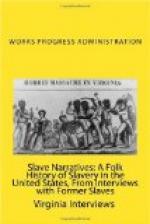“McCaslin was a low heavy set man and he rented out hacks and horses in Atlanta and pa drove, greased the harness and curried and sheared the horses. Master McCaslin brought them in town and rented them out. He didn’t have a livery stable. He just furnished conveyances. I heard him tell about a good hitching post where he could more than apt rent out his rig and how he always stopped and fed the horses when eating time come. He took a feed box all the time. Master McCaslin would tell him to not drive too hard when he had to make long drives. He never would let him take a whoop.
“He had some girls I heard him say. May and Alice was their names. He didn’t say much about the family. He took a basket of provision with him to eat Miss May and Miss Alice fixed up. The basket was close wove and had a lid. The old man farmed. He drove too. He drove a hack. Ma worked in the field. I heard her tell about the cockleburs. Well, she said they would stick on your dress and stick your legs and you would have to pick them off and sometimes the beggar’s-lice would be thick on their clothes and they would pick them off.
“When they would clean out the fence corners (rail fence) they would leave every little wild plum tree and leave a whole lot of briers so they would have wild plums and berries. They raised cotton. Sometime during the War old Master McCaslin took all his slaves and stock way back in the bottoms. The cane was big as ma’s wrist she said. They put up some cabins to live in and shelter the stock. Pa said some of em went in the army. He didn’t want to go. They worked a corn crop over in there.
“They left soon as they was freed. I don’t know how they found it out. They walked to way over in Alabama and pa made terms with a man, to come to Mississippi. Then they come in a wagon and walked too. She had three little children. I was [HW: born] close to Montgomery, Alabama in September but I don’t know how long it was after the War. I was the first girl. There was two more boys and three more girls after me. Ma had children born in three states.
“Ma died with the typhoid fever. Then two sisters and a brother died. Pa had it all summer and he got well. Miss (Mrs.) Betty Chamlin took us children to a house and fed us away from ma and the sick girls and boy. We was on her place. She had two families then. We got water from a spring. It was a pretty spring under a big hill. We would wade where the spring run off. She moved us out of that house.
“Miss Betty was a widow. She had several boys. They worked in the field all the time. We stayed till the boys left and she sold her place. She went back to her folks. I never did see her no more. We scattered out. Pa lived about wid us till he died. I got three girls living. I got five children dead. I got one girl out here from town and one girl at Meridian and my oldest girl in Memphis. I takes it time around wid em.




